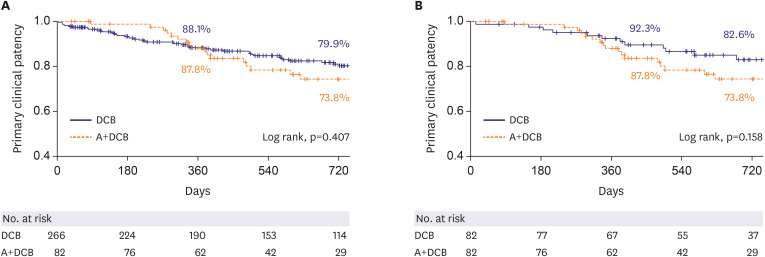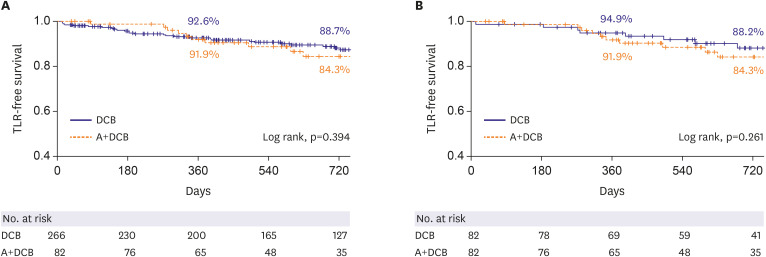Korean Circ J.
2022 Feb;52(2):123-133. 10.4070/kcj.2021.0246.
Clinical Outcomes of Atherectomy Plus Drug-coated Balloon Versus Drugcoated Balloon Alone in the Treatment of Femoropopliteal Artery Disease
- Affiliations
-
- 1Division of Cardiology, Korea University Anam Hospital, Korea University College of Medicine, Seoul, Korea
- 2Division of Cardiology, Chungnam National University Sejong Hospital, Sejong, Korea
- 3Division of Cardiology, Severance Cardiovascular Hospital, Yonsei University College of Medicine, Seoul, Korea
- 4Division of Cardiology, Yongin Severance Hospital, Yonsei University College of Medicine, Yongin, Korea
- KMID: 2525451
- DOI: http://doi.org/10.4070/kcj.2021.0246
Abstract
- Background and Objectives
Atherectomy as a pretreatment has the potential to improve the outcomes of drug-coated balloon (DCB) treatment by reducing and modifying atherosclerotic plaques. The present study investigated the outcomes of atherectomy plus DCB (A+DCB) compared with DCB alone for the treatment of femoropopliteal artery disease.
Methods
A total of 311 patients (348 limbs) underwent endovascular therapy using DCB for native femoropopliteal artery lesions at two endovascular centers. Of these, 82 limbs were treated with A+DCB and 266 limbs with DCB alone. After propensity score matching based on clinical and lesion characteristics, a total of 82 pairs was compared for immediate and mid-term outcomes.
Results
For the matched study groups, the lesion length was 172.7±111.2 mm, and severe calcification was observed in 43.3%. The technical success rate was higher in the A+DCB group than in the DCB group (80.5% vs. 62.2%, p=0.015). However, the A+DCB group showed more procedure-related minor complications (37.0% vs. 13.4%, p=0.047). At 2-year follow-up, primary clinical patency (73.8% vs. 82.6%, p=0.158) and the target lesion revascularization (TLR)-free survival (84.3% vs. 88.2%, p=0.261) did not differ between the two groups. In Cox proportional hazard analysis, atherectomy showed no significant impact on the outcome of DCB treatments.
Conclusions
The pretreatment with atherectomy improved technical success of DCB treatment; however, it was associated with increased minor complications. In this study, A+DCB showed no clinical benefit in terms of TLR-free survival or clinical patency compared with DCB treatment alone.
Figure
Cited by 1 articles
-
Improving the Outcomes of Complex Lesions of the Femoropopliteal Artery Using Atherectomy and Drug Coated Balloon
Sangmin Kim
Korean Circ J. 2022;52(2):134-135. doi: 10.4070/kcj.2021.0396.
Reference
-
1. Ko YG, Ahn CM, Min PK, et al. Baseline characteristics of a retrospective patient cohort in the Korean Vascular Intervention Society Endovascular Therapy in Lower Limb Artery Diseases (K-VIS ELLA) Registry. Korean Circ J. 2017; 47:469–476. PMID: 28765738.
Article2. Poulson W, Kamenskiy A, Seas A, Deegan P, Lomneth C, MacTaggart J. Limb flexion-induced axial compression and bending in human femoropopliteal artery segments. J Vasc Surg. 2018; 67:607–613. PMID: 28526560.
Article3. Gerhard-Herman MD, Gornik HL, Barrett C, et al. 2016 AHA/ACC guideline on the management of patients with lower extremity peripheral artery disease: executive summary: a report of the American College of Cardiology/American Heart Association Task Force on Clinical Practice Guidelines. Circulation. 2017; 135:e686–e725. PMID: 27840332.4. Kudagi VS, White CJ. Endovascular stents: a review of their use in peripheral arterial disease. Am J Cardiovasc Drugs. 2013; 13:199–212. PMID: 23579965.
Article5. Tepe G, Laird J, Schneider P, et al. Drug-coated balloon versus standard percutaneous transluminal angioplasty for the treatment of superficial femoral and popliteal peripheral artery disease: 12-month results from the IN.PACT SFA randomized trial. Circulation. 2015; 131:495–502. PMID: 25472980.
Article6. Rosenfield K, Jaff MR, White CJ, et al. Trial of a paclitaxel-coated balloon for femoropopliteal artery disease. N Engl J Med. 2015; 373:145–153. PMID: 26106946.
Article7. Thieme M, Von Bilderling P, Paetzel C, et al. The 24-month results of the Lutonix Global SFA Registry: worldwide experience with Lutonix drug-coated balloon. JACC Cardiovasc Interv. 2017; 10:1682–1690. PMID: 28780030.8. Micari A, Brodmann M, Keirse K, et al. Drug-coated balloon treatment of femoropopliteal lesions for patients with intermittent claudication and ischemic rest pain: 2-year results from the IN.PACT global study. JACC Cardiovasc Interv. 2018; 11:945–953. PMID: 29798770.9. Aboyans V, Ricco JB, Bartelink ME, et al. Editor's Choice - 2017 ESC Guidelines on the Diagnosis and Treatment of Peripheral Arterial Diseases, in collaboration with the European Society for Vascular Surgery (ESVS). Eur J Vasc Endovasc Surg. 2018; 55:305–368. PMID: 28851596.10. Scheinert D, Micari A, Brodmann M, et al. Drug-coated balloon treatment for femoropopliteal artery disease. Circ Cardiovasc Interv. 2018; 11:e005654. PMID: 30354636.
Article11. Fanelli F, Cannavale A, Gazzetti M, et al. Calcium burden assessment and impact on drug-eluting balloons in peripheral arterial disease. Cardiovasc Intervent Radiol. 2014; 37:898–907. PMID: 24806955.
Article12. Katsanos K, Spiliopoulos S, Reppas L, Karnabatidis D. Debulking atherectomy in the peripheral arteries: is there a role and what is the evidence? Cardiovasc Intervent Radiol. 2017; 40:964–977. PMID: 28451812.
Article13. Lee YJ, Ko YG, Ahn CM, et al. Outcomes of adjunctive drug-coated versus uncoated balloon after atherectomy in femoropopliteal artery disease. Ann Vasc Surg. 2020; 68:391–399. PMID: 32339691.
Article14. Zeller T, Langhoff R, Rocha-Singh KJ, et al. Directional atherectomy followed by a paclitaxel-coated balloon to inhibit restenosis and maintain vessel patency: twelve-month results of the DEFINITIVE AR study. Circ Cardiovasc Interv. 2017; 10:e004848. PMID: 28916599.
Article15. Cai Z, Guo L, Qi L, et al. Midterm outcome of directional atherectomy combined with drug-coated balloon angioplasty versus drug-coated balloon angioplasty alone for femoropopliteal arteriosclerosis obliterans. Ann Vasc Surg. 2020; 64:181–187. PMID: 31449956.
Article16. Rocha-Singh KJ, Zeller T, Jaff MR. Peripheral arterial calcification: prevalence, mechanism, detection, and clinical implications. Catheter Cardiovasc Interv. 2014; 83:E212–E220. PMID: 24402839.17. Cioppa A, Stabile E, Popusoi G, et al. Combined treatment of heavy calcified femoro-popliteal lesions using directional atherectomy and a paclitaxel coated balloon: One-year single centre clinical results. Cardiovasc Revasc Med. 2012; 13:219–223. PMID: 22632996.
Article18. Zhen Y, Chang Z, Wang C, Liu Z, Zheng J. Directional atherectomy with antirestenotic therapy for femoropopliteal artery disease: a systematic review and meta-analysis. J Vasc Interv Radiol. 2019; 30:1586–1592. PMID: 31471198.
Article19. Tarricone A, Ali Z, Rajamanickam A, et al. Histopathological evidence of adventitial or medial injury is a strong predictor of restenosis during directional atherectomy for peripheral artery disease. J Endovasc Ther. 2015; 22:712–715. PMID: 26208657.
Article20. Stavroulakis K, Schwindt A, Torsello G, et al. Directional atherectomy with antirestenotic therapy vs drug-coated balloon angioplasty alone for isolated popliteal artery lesions. J Endovasc Ther. 2017; 24:181–188. PMID: 28008792.
Article21. Stavroulakis K, Schwindt A, Torsello G, et al. Directional atherectomy with antirestenotic therapy vs drug-coated balloon angioplasty alone for common femoral artery atherosclerotic disease. J Endovasc Ther. 2018; 25:92–99. PMID: 29251204.
Article22. Krishnan P, Tarricone A, Purushothaman KR, et al. An algorithm for the use of embolic protection during atherectomy for femoral popliteal lesions. JACC Cardiovasc Interv. 2017; 10:403–410. PMID: 28231909.
Article23. Wasty N, Khakwani MZ, Kotev S, et al. Ubiquitous nature of distal athero/thromboembolic events during lower extremity atherectomy procedures involving the superficial femoral artery. Int J Angiol. 2016; 25:252–257. PMID: 27867291.
Article24. Boitet A, Grassin-Delyle S, Louedec L, et al. An experimental study of paclitaxel embolisation during drug coated balloon angioplasty. Eur J Vasc Endovasc Surg. 2019; 57:578–586. PMID: 30871939.
Article25. Scheinert D, Schmidt A, Zeller T, et al. German center subanalysis of the LEVANT 2 global randomized study of the Lutonix drug-coated balloon in the treatment of femoropopliteal occlusive disease. J Endovasc Ther. 2016; 23:409–416. PMID: 27117972.
Article26. Kohi MP, Brodmann M, Zeller T, et al. Sex-related differences in the long-term outcomes of patients with femoropopliteal arterial disease treated with the IN.PACT drug-coated balloon in the IN.PACT SFA randomized controlled trial: a post hoc analysis. J Vasc Interv Radiol. 2020; 31:1410–1418.e10. PMID: 32868016.
Article
- Full Text Links
- Actions
-
Cited
- CITED
-
- Close
- Share
- Similar articles
-
- Improving the Outcomes of Complex Lesions of the Femoropopliteal Artery Using Atherectomy and Drug Coated Balloon
- Experience in High Speed Rotational Coronary Atherectomy
- Early and Late Clinical Outcomes after Directional Coronary Atherectomy
- Multiple drug-coated balloons can be used effectively for peripheral arterial disease including long femoropopliteal lesions
- Directional Coronary Atherectomy (Simpson AtheroCath) : Reasons for Device Selection, Angiographic and Histologic Findings, and Its Mechanisms



